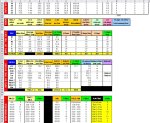There is an advanced and updated version of this log now (please click here to go to it).
If your friend had told you about this log, please tell them of the update in case they had not downloaded the 2011 update.
I keep this post up for those who had used this and found it sufficient for their needs and don’t want to deal with changes. Thank you.
This is an Excel spreadsheet running log I created, used and have improved for 10 years, which I would like to share with you.
Blank Run Log, by Minh Tan (1.5MB Excel file, updated Sep 16 2009)
I think it is fairly easy to learn and use, after 10 years of finessing out anything that still really annoys me. Instructions are included and cells you should not touch are locked to help avoid unintentional formula deletions and make it more user-friendly. It handles two runs per day and four extra types of workouts, plus up to 10 interval spaces for any workout so unless you train more than that (and I do know people that do!), this should suffice.
This spreadsheet does not have interfaces with new GPS and Heart Rate Monitors. I’m still training old skool on a 1998 Polar HRM.
I only regret to say I will not be providing technical support for this, unless you know me and can talk to me about it directly. I am sharing it out of good will and would like to minimize efforts beyond that. However, I welcome all feedback and suggestions. If I can do anything about it, I will to upgrade the file. That is why the date is beside the download. Otherwise, you can customize it further for yourself by adding your own worksheets and features within the file to suit your needs.
If you like it or want to show this post to your friends, you can either email the link or click on one of the social bookmarking tools in the bar below (for my less Net savvy friends). Thank you.
More about the Excel Running Log
The spreadsheet log requests a fair bit of data, of which you can decide how much or how little you want to enter. That, will in turn influence how much the log will be able to feed back to you about your training. It’s only as good as you are at keeping your own data, basically.
Detailed instructions are supplied on the worksheet you open the downloaded file to, but in the future, it should open to whatever page you closed and saved the file on. Instructions are probably only needed for your set-up and first few time you use it. It should become routine fairly quickly once you get the gist of it.
Among the data the log requests are time, distance (miles or km and you can change it for each entry), shoes worn to monitor your shoe mileage, etc. With some of this data, it does calculations, like pace given time and distance. With other data, it just gives you space to keep like comments, temperature (useful if you keep track of what you wore in your comments, for example), non-running workouts, your intervals that are not automatically comparable from time to time since intervals and workouts may change, and so on. An example of a filled out week is below (Pic #1).
Please use “k” for kilometre or “m” for miles under column E of “Distance”, to tell the spreadsheet what unit your number entered was in for the distance ran”.
Beyond the workout data and calculations, it also provides a summary chart with totals and averages of all sorts (Pic #2).
There are also graphic displays of this information for the visual types, as well as a more integrated look at your training (Pics #3 – #7).
Is that enough information for you? 🙂
I hope you enjoy it. All feedback are welcomed as if I can do anything about it, I will and update the file here accordingly. I hope you will find this of value. Thank you!
-

-
#1 – Run Log Data
-

-
#2 – Run Log Summary
-

-
#3 – Running Distribution Graph
-

-
#4 – Distance Ran Graph
-

-
#5 – Pace Graph
-

-
#6 – Time Ran Graph
-

-
#7 – Workout Distribution Graph
-

Flesch-Kincaid Grade Reading Level: 6.8
 On June 9th, 2014, the Scientific American blog Beautiful Minds had a rather in-depth article called Will the Real Introverts Please Stand Up? about what introversion really meant (and extraversion as the opposite). The term is still highly misunderstood, whether from generic social definitions, or more precise and complex definitions through the works of Myers-Briggs and others following.
On June 9th, 2014, the Scientific American blog Beautiful Minds had a rather in-depth article called Will the Real Introverts Please Stand Up? about what introversion really meant (and extraversion as the opposite). The term is still highly misunderstood, whether from generic social definitions, or more precise and complex definitions through the works of Myers-Briggs and others following.



 Jan 2 2015 update
Jan 2 2015 update





